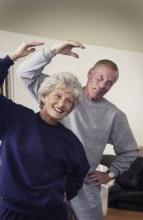Home-based and group exercise programs are the interventions that most significantly reduce falls among elderly community-dwelling patients, according to an update published online Sept. 11 in the Cochrane Database of Systematic Reviews.
Home safety interventions also reduce falling, especially among elderly people at highest risk and especially when the interventions are performed by occupational therapists.
In contrast, walking programs, vitamin D supplementation, hormone replacement therapy, adjustment of medication regimens, nutritional therapy, cognitive behavioral therapy, vision improvement interventions, and withdrawal of psychotropic drugs do not decrease falls. And interventions such as footwear assessment, foot and ankle exercises, cataract surgery, pacemaker insertion, and patient education only appear to benefit select patient populations, Dr. Lesley D. Gillespie of the University of Otago, Dunedin, New Zealand, and associates wrote (Cochrane Database Syst. Rev. 2012 [doi: 10.1002/14651858.CD007146.pub3]).
The investigators performed a systematic review of the literature and meta-analysis of 159 randomized clinical trials assessing interventions aimed at reducing falls among the elderly, to update the existing Cochrane Review of the subject that was published in 2009. The update includes 51 new trials that were performed after the publication of that initial Cochrane Review.
These clinical trials were conducted in 21 countries, and included 79,193 participants aged 60 years and older. The median sample size was 230 study subjects (range, 10-9,940 subjects), and 70% of the participants were women.
The effects of each intervention on both the rate of falls (the number of falls per person per year) and the risk of falling (the number of people who fell once or more during follow-up) were assessed for each intervention.
Fifty-nine trials specifically examined the effectiveness of various exercise programs in preventing falls, including gait training, balance training, functional training, muscle strength/resistance training, 3-D training (constant, repetitive movement through all three spatial planes), tai chi, and general physical activity such as walking.
Programs that contained more than one of these components were the most successful. Both home-based and group programs achieved a statistically significant reduction in both the rate of falls and the risk of falling. However, resistance training was associated with an increase in adverse events such as musculoskeletal injury and bursitis.
Tai chi alone significantly reduced the risk of falling, but the decrease in the rate of falls was of borderline significance only.
General activity such as walking did not reduce the rate or the risk of falling.
Medication interventions generally were ineffective at reducing falls, the researchers said.
Even though four new clinical trials involving nearly 6,000 patients examined vitamin D supplementation (with or without calcium), the treatment reduced falls only in those patients who had low serum levels of vitamin D at baseline. The vitamin D analogues calcitriol and alfacalcidol were associated with increased hypercalcemia.
Other medical interventions that were as ineffective included hormone therapy; the gradual withdrawal of psychotropic medications used to improve sleep, reduce anxiety, or treat depression; the adjustment of current medication regimens; and nutritional supplementation. The exception to this finding was a single program in which family physicians were given education by a clinical pharmacist, feedback on their prescribing practices, and financial incentives; their subsequent review and modification of elderly patients’ medication regimens did significantly reduce falls.
Surgical interventions to reduce falls included cataract surgery to improve vision and cardiac pacemaker insertion to decrease dizzy spells. A first cataract operation reduced the rate of falls but not the risk of falling, and subsequent cataract operations did not affect falls. Pacemakers cut the rate of falls in only the subgroup of patients who had cardioinhibitory carotid sinus hypersensitivity that induced sudden changes in heart rate and blood pressure, and they did not decrease the risk of falling in any patient group.
Other, nonsurgical interventions to improve vision actually increased the rate of falls and the risk of falling. One trial found that patients given vision assessment, eye examinations, new eyeglasses, referral for expedited treatment of any ophthalmologic problems, mobility training, and canes actually had higher rates of falls and higher risks of falling than did control subjects. Another trial showed that replacing multifocal eyeglasses with single-lens distance glasses for activities that involved walking and standing failed to reduce the rate or risk of falls overall, and actually increased outdoor falls among the frailer patients.
Interventions that addressed environmental issues or provided assistive technology produced mixed results. Assessing the safety of the home environment and making modifications prevented falls, especially in patients at highest risk of falling, such as those with severe visual impairment. A post hoc analysis showed that these interventions were significantly more effective when performed by an occupational therapist rather than other personnel.


